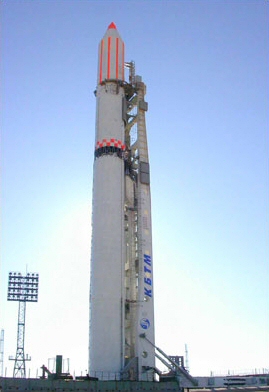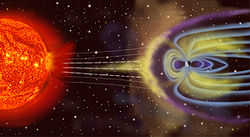
Space weather is a branch of space physics and aeronomy, or heliophysics, concerned with the varying conditions within the Solar System and its heliosphere. This includes the effects of the solar wind, especially on the Earth's magnetosphere, ionosphere, thermosphere, and exosphere. Though physically distinct, space weather is analogous to the terrestrial weather of Earth's atmosphere. The term "space weather" was first used in the 1950s and popularized in the 1990s. Later, it prompted research into "space climate", the large-scale and long-term patterns of space weather.

Earth's magnetic field, also known as the geomagnetic field, is the magnetic field that extends from Earth's interior out into space, where it interacts with the solar wind, a stream of charged particles emanating from the Sun. The magnetic field is generated by electric currents due to the motion of convection currents of a mixture of molten iron and nickel in Earth's outer core: these convection currents are caused by heat escaping from the core, a natural process called a geodynamo.

A geomagnetic storm, also known as a magnetic storm, is a temporary disturbance of the Earth's magnetosphere caused by a solar wind shock wave.

Deep Space Climate Observatory is a National Oceanic and Atmospheric Administration (NOAA) space weather, space climate, and Earth observation satellite. It was launched by SpaceX on a Falcon 9 v1.1 launch vehicle on 11 February 2015, from Cape Canaveral. This is NOAA's first operational deep space satellite and became its primary system of warning Earth in the event of solar magnetic storms.

Ørsted is an Earth science satellite launched in 1999 to study the Earth's geomagnetic field. It is Denmark's first satellite, named after Hans Christian Ørsted (1777–1851), a Danish physicist and professor at the University of Copenhagen, who discovered electromagnetism in 1820.

Time History of Events and Macroscale Interactions during Substorms (THEMIS) mission began in February 2007 as a constellation of five NASA satellites to study energy releases from Earth's magnetosphere known as substorms, magnetic phenomena that intensify auroras near Earth's poles. The name of the mission is an acronym alluding to the Titan Themis.

The Space & Upper Atmosphere Research Commission, commonly referred to as SUPARCO, is an agency of the Government of Pakistan responsible for the national space program.

The Romanian Space Agency is a public institution that coordinates Romania's national space technology research programs and activities related to space research. ROSA, established in 1991, is subordinate to the Romanian Ministry of Education.

The Pakistan Meteorological Department (PMD) (Urdu: محکمہ موسمیات پاکستان, also known as Pakistan Met Office), is an autonomous and independent institution tasked with providing weather forecasts and public warnings concerning weather for protection, safety and general information.

The Badr-B is the second spacecraft and the first Earth observation satellite launched into Earth orbit on 10 December 2001 at 09:15 by the SUPARCO — Pakistan's national space agency. Badr-B is a microsatellite, with a mass of ~70 kg, and contained the computerized system to conduct the studies on the gravity gradient. Badr-B is a research satellite to explore the upper atmosphere and the near space, and carried a large array of instruments for geophysical research.
Colaba Observatory, also known as the Bombay Observatory, was an astronomical, timekeeping, geomagnetic and meteorological observatory located on the Island of Colaba, Mumbai (Bombay), India.

The International Real-time Magnetic Observatory Network (INTERMAGNET) is a world-wide consortium of institutes operating ground-based magnetometers recording the absolute level of the Earth's time-varying magnetic field, to an agreed set of standards. INTERMAGNET has its roots in discussions held at the Workshop on Magnetic Observatory Instruments in Ottawa, Canada, in August 1986 and at the Nordic Comparison Meeting in Chambon La Foret, France, in May 1987. A pilot scheme between USGS and BGS was described in the sessions of Division V of the International Association of Geomagnetism and Aeronomy at the 19th General Assembly of the International Union of Geodesy and Geophysics in Vancouver, Canada, in August 1987. This scheme used the GOES East satellite to successfully transfer geomagnetic data between the two organisations. INTERMAGNET was founded soon after in order to extend the network of observatories communicating in this way. 62 different institutes are now members of the INTERMAGNET consortium, and, since 1991, data have been contributed to INTERMAGNET from approximately 150 observatories. INTERMAGNET is a member of the World Data System of the International Science Council, and it is closely associated with the International Association of Geomagnetism and Aeronomy.
The Pakistan Remote Sensing Satellite (PRSS), commercially known as Remote Sensing Satellite System (RSSS), is a dual-purpose Earth observational and optical satellite. Pakistan Remote Sensing Satellite-1 (PRSS-1) was launched from China's Jiuquan Satellite Centre on 9 July 2018.
The Space Programme 2040 is a satellite development and launch programme of the Space and Upper Atmosphere Research Commission (Suparco), Pakistan's space research authority. The Space programme 2040 intends to replace the Badr satellite programme and geo-stationary communication satellite. On 11 August 2011, Paksat-IR was launched from Xichang Satellite Launch Center by China, making it first satellite to be launched under this programme. According to Suparco, five GEO satellites and six low Earth orbit (LEO) satellites will be launched between 2011 and 2040.

The Lunar prediction program is an active scientific mission of the Space Research Commission (SUPARCO), aims to conduct studies and predicts the appearances and phases of the Moon. On a regular and monthly basis, Suparco provides illustrative predictions for the visibility and the parameters for the sighting of the full new Moon in the various cities of Pakistan.
Praful D. Bhavsar was an Indian space scientist who held several major positions in the Indian Space program including the Project Scientist for the first rocket launch into space from Indian soil on 21 November 1963. In 1986, he retired from the position of Director, Space Applications Centre of the Indian Space Research Organization (ISRO) and the Director, Indian Remote Sensing Satellite Utilization Program.

The Heliophysics Science Division of the Goddard Space Flight Center (NASA) conducts research on the Sun, its extended Solar System environment, and interactions of Earth, other planets, small bodies, and interstellar gas with the heliosphere. Division research also encompasses geospace—Earth's uppermost atmosphere, the ionosphere, and the magnetosphere—and the changing environmental conditions throughout the coupled heliosphere.

The Institute for Astronomy, Astrophysics, Space Applications, and Remote Sensing is a non-profit research institute in Greece with expertise in multidisciplinary astrophysical, space and environmental sciences. It is an independent research Institute of the National Observatory of Athens (NOA) established in 2012 from the merging of the Institute of Astronomy and Astrophysics and the Institute of Space Applications and Remote Sensing. The scientists of the Institute have broad knowledge in various areas of observational Astrophysics, Space Science and Earth observation techniques and their applications. They have established collaborations with research groups in Europe and United States, and their work is recognized through publications in refereed journals, invited talks at international conferences, and coordination of EU-funded and ESA-funded research projects. More details on the IAASARS and its activities can be found in its annual report.

Solar phenomena are natural phenomena which occur within the atmosphere of the Sun. They take many forms, including solar wind, radio wave flux, solar flares, coronal mass ejections, coronal heating and sunspots.

Space climate is the long-term variation in solar activity within the heliosphere, including the solar wind, the Interplanetary magnetic field (IMF), and their effects in the near-Earth environment, including the magnetosphere of Earth and the ionosphere, the upper and lower atmosphere, climate, and other related systems. The scientific study of space climate is an interdisciplinary field of space physics, solar physics, heliophysics, and geophysics. It is thus conceptually related to terrestrial climatology, and its effects on the atmosphere of Earth are considered in climate science.
















